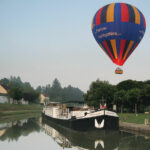A city as well as a summer resort, Konigswinter is located on the right bank of the Rhine River, at the foot of the Siebengebirge in Germany. Konigswinter is a complex city that consists of the “main city” straight in the Rhine valley and the suburb of “Dollendorf” on one side and a number of bigger and smaller villages in the Siebengebirge, such as Ittenbach, Oberpleis, Stieldorf, Heisterbach or Thomasberg on the other side.
Konigswinter has many wonderful sights to offer. The romantic Drachenfels, the hill overlooking the city presents a spectacular view. It is surmounted by the remains of a castle built in the early 12th century by the archbishop of Cologne. The summit of the hill can be approached by the Drachenfels Railway and here you will be enthralled to see a magnificent view, immortalized by Lord Byron in his unforgettable poem Childe Harold’s Pilgrimage.
According to a legend, a cave in the hill has sheltered the dragon (German: Drachen) which was killed by the hero Siegfried. The mountain is quarried and provided stone for the construction of Cologne Cathedral since1267. The Schloss Drachenberg, a neogothic castle built in 1883, stands on the north side of the hill.
Siebengebirge also offers several stunning places in the forests and many breathtaking views on the Rhine valley. Once you have visited the city of Konigswinter, you can go ahead and explore the “Siebengebirge”.
You can start your trip into the forests from”Margarethenhöhe” which is around 520 kilometers from Königswinter and can be approached by bus or by car. Parking places are normally available here, but you have to pay for them. From here you can go to the Ölberg which is about half an hour. It is the highest mountain in the area, with a delightful view of the landscape. Next, you can stroll to the Löwenburg which is an old castle belonging to the middle ages and persists in ruins today. You can also go to the Milchhäuschen, a small restaurant in the forest and then to the Drachenfels. If you want to visit Oberdollendorf marked by tiny old houses and wine restaurants, you can catch the bus 521. You can also go to Heisterbach, the remains of a church inside the forest.
You can book your family vacation on board our European river cruise or German river cruise or Rhine river cruise and visit the amazing city of Kongiswinter!
For more information contact: Europeanbarging, 888-869-7907, jan@europeanbarging.com

